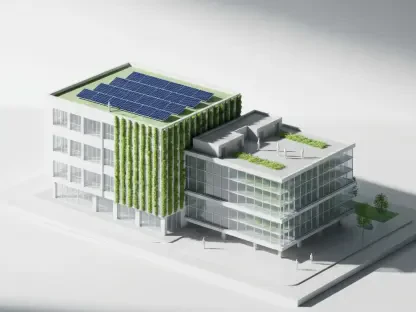In the ever-evolving landscape of urban development, Luca Calarailli stands out as a luminary in construction, design, and architecture. With a passion for integrating technology to drive innovation, Luca offers insights into the transformation of the Merrion Centre in Leeds. This redevelopment marks the introduction of residential accommodations, a notable shift since the center’s inception over 61 years ago. Through the thoughtful repurposing of Wade House and the construction of a contemporary tower, Town Centre Securities PLC (TCS) aims to create a sustainable, mixed-use destination within the city.
Can you give us a brief overview of the Merrion Centre’s transformation plans?
The transformation of the Merrion Centre represents a strategic shift towards creating a dynamic, mixed-use urban hub in Leeds. We’re repurposing Wade House, a vacant office building from the 1960s, into purpose-built student accommodation enhanced by modern amenities. In tandem, we’re constructing a new 37-story tower to house additional student apartments. This marks the first introduction of residential use to the center, aimed at evolving the estate to meet the city’s changing needs.
What was the inspiration behind converting Wade House into student accommodation?
Wade House is steeped in historical significance within Leeds, making it a compelling candidate for repurposing. The shift to student accommodation aligns with both the growing demand for quality housing among students and the ongoing revitalization initiatives in urban development. This endeavor allows us to respect the heritage of Wade House while providing practical solutions to the city’s expanding educational community.
How does the new 37-story tower complement the existing Wade House building in the overall design?
The design of the 37-story tower is crafted to harmonize with the architectural integrity of Wade House while offering a modern aesthetic that resonates with the landscape of Leeds. The tower stands as a symbol of progression, complementing the historical office building by introducing facilities and space conducive to student life, all while maintaining a cohesive look and feel for the Merrion Centre.
With 1,039 student bedrooms planned, what types of accommodations or layouts will be offered?
The development will offer a mix of studio apartments and cluster accommodations, catering to varied preferences and needs of the student demographic. Studios provide a self-contained environment ideal for independent living, while cluster apartments encourage community interaction among our residents. This blend ensures we address both private and communal aspects of student life.
Can you explain some of the amenities that will be available to residents in this new development?
We’re investing in top-tier amenities designed to enrich the student experience. Residents will have access to lounges for relaxation, coworking spaces for academic collaboration, a cinema for leisure, and a gym for wellness. Additional features like karaoke rooms, external terraces, and secure cycle spaces make living at the Merrion Centre a vibrant and convenient choice for students.
Why did TCS decide to include residential use at the Merrion Centre after 61 years?
TCS is committed to evolving the Merrion Centre as a vital part of Leeds’ urban fabric. By incorporating residential elements, we adapt to the city’s burgeoning population and housing needs. This decision is part of a broader strategy to diversify and future-proof the estate, ensuring it meets the city’s multifaceted demands now and into the future.
What were some of the challenges you faced during the planning and approval process with Leeds City Council?
The planning and approval process was a meticulous endeavor, spanning over three years. We collaborated closely with Leeds City Council to refine our designs, ensuring they were sensitive to the existing site structures and committed to sustainability. The challenge lay in balancing heritage conservation with modern design, alongside addressing logistical considerations of urban development.
How has TCS worked to ensure that the development is both sensitive to the existing site and sustainable for the future?
Sensitivity in design and sustainability are the cornerstones of our approach. We meticulously consider heritage preservation while integrating sustainable building practices. Our decision to refurbish Wade House aligns with eco-friendly principles, reducing the need for new resources, and we incorporate energy-efficient technologies across the site to minimize the environmental footprint.
How does repurposing Wade House respect its heritage?
Repurposing Wade House involves preserving its architectural integrity while adapting it for contemporary use. We’ve maintained key historical elements, ensuring they mesh seamlessly with our modern design strategies. This approach allows us to honor the building’s historical context while equipping it for new purposes that serve the growing student population.
In what ways does this development support Leeds’ growing population needs?
The development is poised to significantly bolster Leeds’ housing resources, particularly within the student segment. By providing quality living spaces proximal to educational institutions and urban amenities, we address a critical need in the community. This expansion helps accommodate the city’s population growth and supports economic vitality through increased foot traffic in the area.
Can you elaborate on your strategy to diversify and future-proof the Merrion estate?
Our strategy focuses on enhancing the Merrion Centre as a mixed-use destination that caters to retail, leisure, office, and residential needs. Diversification is key—it allows us to adapt to market demands and ensure the estate remains relevant. Future-proofing involves sustainable practices and innovative design to ensure long-term viability in Leeds’ economic landscape.
How has the Merrion Centre evolved over the years to meet the needs of the city?
The Merrion Centre has continually adapted since its opening in 1964, evolving with shifts in retail and commercial trends. We’ve invested in numerous refurbishments and expansions aimed at providing diverse services and experiences. This adaptability has maintained the center’s status as an iconic destination, welcoming millions of visitors annually.
What role do you see the Merrion Centre playing in the future of Leeds as a mixed-use destination?
I envision the Merrion Centre as a central player in Leeds’ urban ecosystem. By combining residential, retail, leisure, and office spaces, the center can function as a catalyst for social and economic activities. Its strategic location, coupled with multifaceted offerings, positions it to support the city’s growth and dynamism.
How does the Merrion Centre’s proximity to the first direct Arena and key transport links benefit this new development?
The Merrion Centre’s location is one of its strongest assets. Proximity to the first direct Arena and key transport links enhances accessibility, making it an attractive choice for students and visitors alike. This connectivity enables easy movement and interaction with city-wide events and services, which amplifies the tenant experience and fosters community engagement.
What has been the response from key stakeholders about this new student accommodation project?
Stakeholders have expressed enthusiastic support for the project, recognizing its potential to invigorate the city’s housing landscape. They appreciate the consideration given to heritage aspects and sustainability. The collaborative planning effort with stakeholders underscores a shared vision for an invigorated Merrion Centre, poised to elevate Leeds’ mixed-use offerings.
What are the next steps now that the planning approval has been granted?
Following approval, we’ll transition into the detailed design phase and preparation for construction. We’re focused on executing the infrastructure and architectural plans while liaising closely with contractors to assure quality and timeliness. This phase demands precision to translate our vision into a living, breathing development that fulfills its intended purpose.
How does this new scheme fit into TCS’s long-term vision for the Merrion estate?
This scheme is pivotal to TCS’s long-term vision of transforming the Merrion Centre into a sustainable and diverse estate. Introduction of residential components exemplifies our commitment to meeting the city’s evolving needs through strategic growth. The initiative is part of an overarching plan to foster an adaptable urban environment that thrives amid Leeds’ development trajectory.
What impact do you expect this development to have on the local community and businesses?
We anticipate a positive impact, boosting local commerce by increasing foot traffic and providing new business opportunities. The presence of students will infuse vibrancy into the community, fostering interactions that benefit local retail and leisure establishments. The development serves as a nexus for economic and social activities, contributing to the city’s enduring vitality.
Do you have any advice for our readers?
In the realm of real estate development, embracing innovation while honoring heritage is crucial. For those in the field, consider how technology can enhance environmental responsibility and community engagement. Always prioritize adaptability—cities evolve, and successful projects are those that can pivot with changing demographics and needs.









